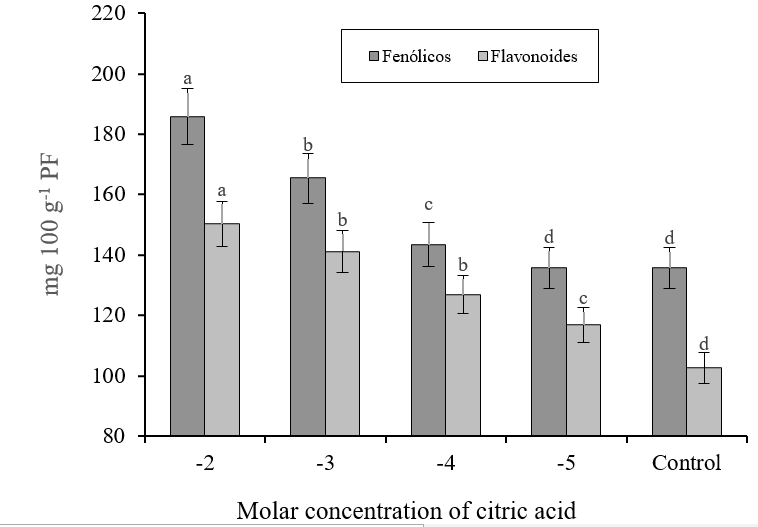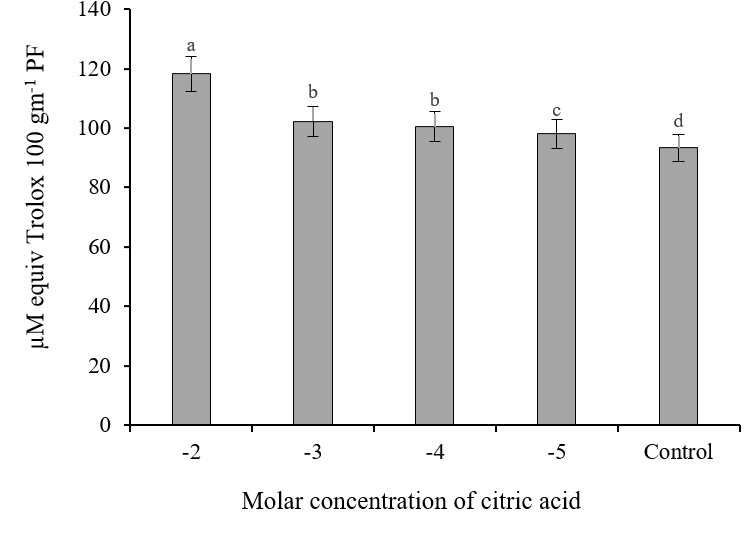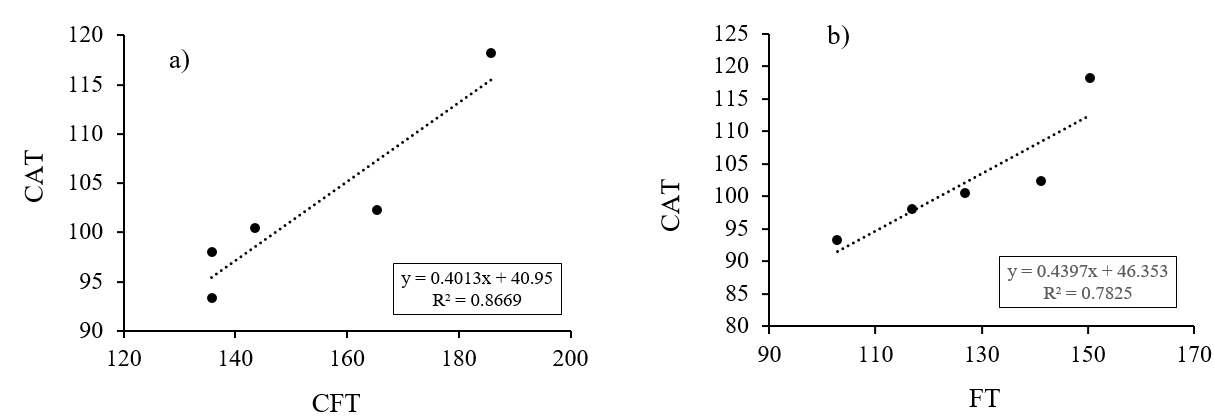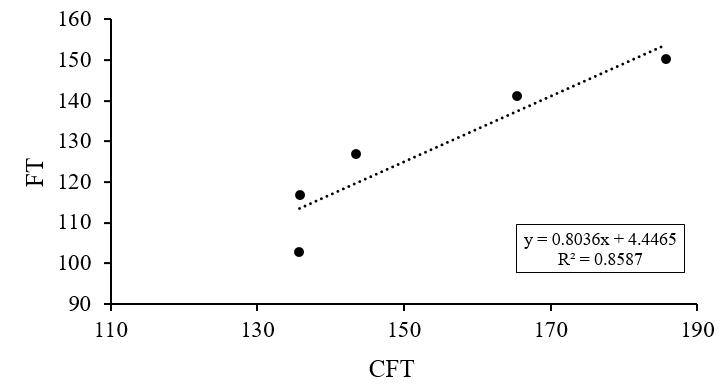Services on Demand
Journal
Article
Indicators
-
 Cited by SciELO
Cited by SciELO -
 Access statistics
Access statistics
Related links
-
 Similars in
SciELO
Similars in
SciELO
Share
Revista mexicana de ciencias agrícolas
Print version ISSN 2007-0934
Rev. Mex. Cienc. Agríc vol.9 spe 20 Texcoco Apr./May. 2018
https://doi.org/10.29312/remexca.v0i20.999
Articles
The application of citric acid increases the quality and antioxidant capacity of lentil sprouts
1Polytechnic University of Gómez Palacio. Gómez Palacio, Durango, Mexico. (lsalas@upgop.edu.mx).
2Division of Graduate Studies and Research-Technological Institute of Torreón, Coahuila, Mexico. (jazmontse@hotmail.com; dmilys5@hotmail.com).
3Autonomous Agrarian University Antonio Narro. (jagf252001@gmail.com).
4National Institute of Agricultural and Cattle Forestry Research. (ayala.alma@inifap.gob.mx).
The content of antioxidant compounds in lentil sprouts is related to the prevention and treatment of degenerative diseases. This type of compounds could be increased by the application of elicitors such as citric acid, which promotes the synthesis of compounds derived from phenylpropanoids and activates signaling cascade that increase antioxidant activity. The objective of the present investigation was to evaluate the effect of the spray application of citric acid (0, 10-2, 10-3, 10-4 and 10-5 M) on the content of total phenolic compounds, total flavonoids, capacity total antioxidant of lentil sprouts. A completely randomized design with six repetitions of treatment was used. The results showed that citric acid significantly increased phenolic compounds and total flavonoids. The highest value of phenolic compounds and flavonoids was obtained with the 10-2 M treatment of citric acid with 185.5, 150 mg 100 g-1 fresh weight respectively. Likewise, the antioxidant capacity was greater with the same treatment (10-2 M), which agrees with the correlation results obtained that indicate that the antioxidant capacity is due in 86 and 78% to the phenolic and flavonoid compounds, respectively. It is concluded that the application of molar concentrations of molecules that induce secondary metabolism during the stage of germinating development is a useful and effective method to stimulate the biosynthesis of bioactive phytochemicals and improve the antioxidant capacity of this type of food.
Keywords: Lens culinaris; citric acid; nutraceutical quality
El contenido de compuestos antioxidantes en germinados de lenteja se relaciona con la prevención y el tratamiento de enfermedades degenerativas. Este tipo de compuestos podrían incrementarse por la aplicación de elicitores como el ácido cítrico, el cual promueve la sintésis de compuestos derivados de los fenilpropanoides y activa cascada de señalización que incrementan la actividad antioxidante. El objetivo de la presente investigación fue evaluar el efecto de la aplicación por aspersión de ácido cítrico (0, 10-2, 10-3, 10-4 y 10-5 M) en el contenido de compuestos fenólicos totales, flavonoides totales, capacidad antioxidante total de germinados de lenteja. Se utilizó un diseño completamente al azar con seis repeticiones de tratamiento. Los resultados mostraron que el ácido cítrico incremento significativamente los compuestos fenólicos y flavonoides totales. El valor más alto de compuestos fenólicos y flavonoides se obtuvo con el tratamiento 10-2 M de ácido cítrico con 185.5, 150 mg 100 g-1 peso fresco respectivamente. Igualmente, la capacidad antioxidante fue mayor con el mismo tratamiento (10-2 M), lo cual concuerda con los resultados de correlación obtenidos que indican que la capacidad antioxidante se debe en 86 y 78% a los compuestos fenólicos y flavonoides, respectivamente. Se concluye que la aplicación de concentraciones molares de moléculas inductoras del metabolismo secundario durante la etapa de desarrollo de germinados es un método útil y efectivo para estimular la biosíntesis de fitoquímicos bioactivos y mejorar la capacidad antioxidante de este tipo de alimento.
Palabras clave: Lens culinaris; ácido cítrico; calidad nutracéutica
Introduction
Lentil (L. culinaris.) Is a grain that is relatively tolerant to drought, and thrives in many environments (Torino et al., 2013). The largest consumers are in Asia, North Africa, Western Europe and part of Latin America (FAO, 2013). The lentil is a food with a high concentration of nutrients. Carbohydrates are the most abundant (58%) and consist mainly of starch; the lipid content is very low (2.3%) and the contribution of protein and fiber is important with 22 and 18%, respectively (Silva-Cristóbal et al., 2010). Germinated lentils have superior nutritional properties to those of dried ones: their content of vitamins, minerals, trace elements and enzymes can multiply by several hundred during germination (Cueva and Sánchez, 2017).
Lentils germinated under certain conditions have properties against arterial hypertension (Torres-Acosta and Calvo-Araujo, 2011). Other studies indicate that fresh consumption of lentil sprouts provides carbohydrates, fiber, vitamins, nutrients and a high content of phytochemicals with bioactive effect as antidiabetic, anti-inflammatory, anti-cancer, antihypertensive and antioxidant activity (Dziki et al., 2015). These properties are due to the action of secondary metabolites such as phenolic compounds, which have been widely studied and are commonly used as antioxidants for a wide range of applications (Cerón et al., 2010), so their increase in sprouts is a line of research to obtain antioxidants obtained from natural sources, which can become an important innovation for the production of functional foods (González and García, 2012).
Several investigations show an increase in the content of compounds with bioactive properties in sprouts of different species by the application of compounds that function as elicitors since they promote the synthesis of compounds derived from phenylpropanoids and activate signaling cascades that increase antioxidant activity (Świeca et al., 2014). Some of the mentioned works have studied the application of compounds such as hydrogen peroxide (Barba-Espín et al., 2012), yeast bark (Yu Tian et al., 2014), and application of minerals such as selenium and sulfur to improve the content of prosalud compounds (Świeca et al., 2014). On the other hand, the application of organic acids has also shown an increase of this type of compounds in plants (Ulloa et al., 2010, Vázquez-Díaz et al., 2016).
Citric acid improves the antioxidant content of foods, since it stimulates a greater synthesis of nutraceutical compounds that function as antioxidants, among which are the phenolic compounds and flavonoids among them (Pérez-Balibrea et al., 2008). Therefore, the use of citric acid during the period of production of sprouts can be a very useful tool to enhance the synthesis of bioactive compounds. On the other hand, there are no studies available regarding antioxidant capacity, content of phenolic compounds and flavonoids, as well as the quality of soluble sugars and dry matter in lentil sprouts due to the application of citric acid. The objective of the research was to evaluate the effect of the application of different doses of citric acid on the content of total phenolic compounds, total flavonoids, total dry matter antioxidant capacity and soluble sugars in lentil sprouts.
Materials and methods
The present investigation was carried out at the Polytechnic University of Gómez Palacio, in Gómez Palacio, Durango, Mexico, between the geographic coordinates of 25° 32’ - 25° 54’ north latitude and 103° 19’ - 103° 42 west longitude. Lentil seed (Lens culinaris) was used with a germination percentage of 95%. The temperature conditions in the study were 15-18 °C, and distilled water was used to carry out the experiment. First, the seeds were subjected to washing for 15 min by immersion in water with sodium hypochlorite (NaCIO) at a concentration of 1 mL L-1. Subsequently the seeds were rinsed and drained twice to remove the excess NaClO. Then, for the pregermination the methodology of Dziki et al., 2015 was followed, which consisted of immersion in water for 6 h, to then rinse and drain again before germination.
The germination consisted of placing the seeds pregerminated in polystyrene foam containers with an area of 15x10x5 cm, with perforations in the basal part to allow percolation and aeration. The containers were covered with number one blanket and placed for 6 h in the dark. After this time began the growth stage, in which the treatments were applied and lasted for 6 days.
A completely randomized experimental design with four repetitions per treatment was used, which consisted in the application of citric acid (C6H8O7) in concentrations of 0, 10-2, 10-3, 10-4 and 10-5 M. During germination and sowing irrigations were carried out every 3 h exclusively with water, by spraying with an amount of 5 mL per application. The application of the treatments was carried out in the growth stage using the same irrigation dose. The variables evaluated were the content of total phenolic compounds, total flavonoids, total antioxidant capacity, percentage of dry matter and soluble sugars.
To quantify the first three variables, extracts were prepared by mixing 2 g of fresh sample in 10 ml of 80% ethanol in plastic tubes with screw cap, which were placed on a rotary shaker (ATR Inc., USA) for 24 h 20 rpm and at 5 °C. Then, the tubes were centrifuged at 3 000 rpm for 5 min and the supernatant was removed for analysis.
The content of total phenolic compounds (CFT) was determined using a modification of the Folin-Ciocalteu method (Singleton et al., 1999). A calibration curve was made using gallic acid as standard, and the results were recorded in mg of gallic acid equivalent per 100 g on a fresh weight basis (mg AGE 100 g-1 PF). For the quantification of total flavonoids, the method described by Lamaison and Carnet (1990) was used. A calibration curve was made using quercetin as standard. The results were expressed in mg equivalents of quercetin per 100 g based on fresh weight (mg EQ 100 g-1 PF).
The total antioxidant capacity was determined with the DPPH+ in vitro method (Brand-Williams et al., 1995). For which, a solution of DPPH+ (Aldrich, St. Louis, Missouri, USA) in ethanol was prepared, adjusting the absorbance of the solution at 1 100 ±0.01 at a wavelength of 515 nm. A standard curve was prepared with Trolox (Aldrich, St. Louis, Missouri, USA), the results are reported as equivalent antioxidant capacity in μM equivalent in Trolox per 100 g in fresh weight basis (μM equiv Trolox 100 gm-1 PF).
The dry matter was determined following the official method of the AOAC (1990). To determine the content of total soluble solids, 2 g of the macerated sprouts were weighed in a pestle mortar and a few drops were placed in the prism of a refracometer (Atargo, model SPR-N).
For the statistical analysis, the SAS version 9.0 program was used by means of an analysis of variance and for the comparison of means, the Tukey test was used at 0.05 probability. In addition, a Pearson correlation analysis (p≤ 0.05) was performed to detect correlation between the nutraceutical quality variables evaluated.
Results and discussion
The content of total phenolic compounds showed a significant increase due to the application of citric acid (p≤ 0.05) (Figure 1). The 10-2 M treatment showed the highest content with 185.8 mg 100 g PF, followed by the treatment 10-3 M and 10-4 M with 165.44 and 143 .47 mg 100 g-1, respectively. The treatment with the lowest total phenolic content was 10-5 M and this was similar to the control. Citric acid can degrade conjugated phenols such as tannins to other simpler phenolic compounds by hydrolyzing (Larqué-Saavedra et al., 2010). These compounds can accumulate in cellular vacuoles (Tester et al., 2004). The increase of total phenolics in the sprouts could be due to the release of phenolic acids from the decomposition of the cellular constituents in the germinate (Ulloa et al., 2010).

Figure 1 Content of phenolic compounds and flavonoids in wheat germinates subjected to different molar concentrations of citric acid. Values followed by different letter in columns indicate significant statistical difference (Tukey p≤ 0.05).
The content of total flavonoids evaluated in the lentil sprouts (Figure 1) were affected significantly by the different concentrations of citric acid (p≤ 0.05), the values obtained ranged between 103 and 150 mg 100 g-1 PF. The highest flavonoid content was presented in lentil sprouts sprinkled with 10-2 concentration compared to the control that presented 68% the lowest value.
Citric acid increases the synthesis of secondary metabolites such as flavonoids (Reynoso-Camacho et al., 2006), which agrees with the results of this work, since it significantly increased the content of these metabolites. Possibly, the application of the acid activated the signal transduction pathways of the secondary metabolism produced by the plants (Ulloa et al., 2010). This could have an impact on the increase of these compounds because flavonoids are involved in the prevention of chronic degenerative diseases through their antioxidant activity (González-Jiménez et al., 2015).
Antioxidant capacity showed significant difference (p≤ 0.05) (Figure 2). The 10-2 M concentration showed the highest antioxidant capacity, while the 10-5 M concentration and the control showed the lowest values (Figure 2). In this work, the antioxidant capacity can be attributed to the fact that the citric acid stimulated the defense mechanisms of the germinating seed, triggering the accumulation of antioxidant compounds (Yildirim and Dursum, 2009). The antioxidant capacity of a food depends on the nature, concentration of different compounds and the natural antioxidants present in it (Cerón et al., 2010). On the other hand, Swieca and Baraniak (2014) point out that the greater or lesser antioxidant activity does not always go hand in hand with the concentration of phenolic compounds.

Figure 2 Antioxidant capacity in wheat germinates subjected to different molar concentrations of citric acid. Values followed by different letters indicate significant statistical difference (Tukey p≤ 0.05).
To determine the relationship between the antioxidant capacity and the content of phenolic compounds and total flavonoids, a Pearson correlation was performed (Figure 3). The results show that there is a strong positive correlation between the antioxidant capacity and the content of phenolic compounds and flavonoids (r2= 0.86 and r2= 0.78), which suggests that in this work, these compounds are antioxidant in nature. That is, the antioxidant capacity of lentil sprouts is 86% due to phenolic compounds. In addition, the antioxidant capacity in lentil sprouts is due to 78% of the flavonoid content. These results agree with the literature that indicates the potential health benefit of phenolic compounds and flavonoids, attributed mainly to their antioxidant activity (Fredes et al., 2013).

Figure 3 Pearson correlation (r2) between the total antioxidant capacity (CAT) with the content of total phenolics (CFT) and total flavonoids (FT) in lentil sprouts under different molar concentrations of citric acid.
Likewise, a correlation was found between the content of total phenolic compounds and the total flavonoids (Figure 4), these being the main phenolic compounds identified and reported in sprouts (Dziki et al., 2015). The above indicates that there is a positive correlation between the phenolic compounds and the total flavonoid content (r2= 0.85). Being, therefore 85% of the phenolics present in the sprouts, flavonoids.

Figure 4 Pearson correlation (r2) between the content of total phenolic compounds (CFT) and total flavonoids (FT) in lentil sprouts under different molar concentrations of citric acid.
On the other hand, the quality of a food is influenced by its percentage of dry matter because it defines the nutritional quality of it (Anjum et al., 2013). The percentage of dry matter (MS) in the lentil sprouts showed a significant difference (p≤ 0.05) between the citric acid treatments (Table 1), with values between 24 and 32%. The concentration of 10-2 M had the highest percentage of MS, while the rest of the treatments and control were similar. The results suggest that the application of citric acid in higher concentration promotes the accumulation of dry matter in the sprouts, possibly through the participation in the synthesis of growth hormones that control and coordinate cell division (Amin et al., 2016).
Table 1 Average values of soluble sugars and dry matter in lentil sprouts subjected to different molar concentrations of citric acid.
| Citric acid (M) | º Brix | MS (%) |
| -2 | 12 a | 31.77 a |
| -3 | 11.33 ab | 26.96 b |
| -4 | 10.66 bc | 26.08 b |
| -5 | 10.33 c | 24.18 bc |
| Control | 9.66 c | 23.61 bc |
Values with equal letters in each column are equal according to the Tukey test (p≤ 0.05).
Similarly, AB at concentrations of 5-20 mg L-1 stimulates growth and elevates levels of growth promoters in Ammi visnaga L. (Talaat et al., 2014). In addition, the AB increases the dry matter content and yield in soybean plants at concentrations of 100 to 400 mg L-1 (Anjum et al., 2013).
The content of total soluble solids in the lentil sprouts showed significant difference (p≤ 0.05) due to the doses of citric acid evaluated (Table 1), which coincided with the rest of the variables where the highest value was obtained by the 10-2 M concentration with a value of 12 °Brix. The values found are coincident with that reported by Buitrago et al. (2015), who point 12 ºBrix in germinated of Vaccinium meridionale.
Conclusions
The highest value of phenolic compounds and flavonoids was obtained with the treatment of 10-2 M citric acid with 185.5, 150 mg 100 g-1 fresh weight respectively. Likewise, the antioxidant capacity was greater with the same treatment (10-2 M). The application of low concentrations of molecules that induce secondary metabolism during the stage of development of germinates is a useful and effective method to stimulate the biosynthesis of bioactive phytochemicals and improve the antioxidant capacity of this type of food, thus expanding the possibilities of use of this food as an ingredient in functional foods or for fresh consumption.
Literatura citada
Amin, A. A.; Abd El-Kader, A. A.; Shalaby, M. A. F.; Gharib, F. A. E.; Rashad, El-sh M. and Teixeira da Silva, J. A. 2016. Physiological effects of salicylic acid and thiourea on growth and productivity of maize plants in sandy soil. Commun. Soil Sci. and Plant Anal. 44:1141-1155. [ Links ]
Anjum, Sh. A.; Ehsanullah, L. X.; Wang, L.; Saleem, M. F. and Huang, Ch. 2013. Exogenous benzoic acid (BZA) treatment can induce drought tolerance in soybean plants by improving gas-exchange and chlorophyll contents. Aust. J. Crop Sci. 7:555-560. [ Links ]
Barba, E. G.; Hernández, J. A. and Díaz, V. P. 2012. Role of H2O2 in pea seed germination. Plant Signaling Behavior. 7:193-195. [ Links ]
Buitrago, A.; Rojas, J.; Rojas, L.; Velasco, J.; Morales, A.; Peñaloza and Díaz, C. 2015. Essential oil composition and antimicrobial activity of visma macrophylla and fruits collected in Tàchira-Veneuela. Natural Product Comm. 10:375-377. [ Links ]
Brand-Williams, W.; Berset, C. and Cuvelier, M. E. 1995. Use of free radical method to evaluate antioxidant activity. Lebensm Wiss Technol. 28:25-30. [ Links ]
Cerón, I.; Higuita, J. y Cardona, C. 2010. Capacidad antioxidante y contenido fenólico total de tres frutas cultivadas en la región andina. Vector. 5:5-10. [ Links ]
Cueva, T. D. V. y Sánchez, C. A. P. 2017. Características de la cocina macrobiótica y su aplicación en recetas de innovación (Bachelor’s thesis). Universidad de Cuenca. Ecuador [ Links ]
Dziki, Dariusz; Gawlik-Dziki, U.; Kordowska-Wiater M. and Doman-Pytka M. 2015. Influence of elicitation and germination conditions on biological activity of wheat spouts. J. Chem. 2:1-8. [ Links ]
FAO. 2013. Production of Lentils by countries. UN Food and Agriculture Organization. 2013. [ Links ]
Fredes, C.; Montenegro, G.; Santander, F.; Jara, C. and Nuñez, G. 2013. Actividad antioxidante y antimicrobiana de mieles monoflorales de plantas nativas chilenas. Boletín Latinoamericano y del Caribe de Plantas Medicinales y Aromáticas. 12:33-38. [ Links ]
González, G. y García, D. 2012. Ejercicio físico y radicales libres, ¿es necesario una suplementación con antioxidantes? Rev. Inter. Med. Cienc. Act. Fís. Dep. 12:369-88. [ Links ]
González, J. F. E.; Hernández, E. N.; Cooper, B. B. L.; Núñez, B. L. C. y Reyes, R. M. 2015. Empleo de antioxidantes en el tratamiento de diversas enfermedades crónico-degenerativas. Vertientes. Rev. Esp. Cienc. Sal. 18:16-21. [ Links ]
Lamaison, J. L. C. and Carnet, A. 1990. Contents in main flavonoid compounds of Crataegus monogyna Jacq. and Crataegus laevigata (Poiret) D.C. flowers at different development stages. Pharmaceutica Acta Helvetica. 65: 315-320. [ Links ]
Larqué, S. A.; Martin, M. R.; Nexticapan, G. A.; Vergara, Y. S. y Gutiérrez, R. M. 2010. Efecto del ácido salicílico en el crecimiento de plántulas de tomate (Lycopersicum esculentum Mill). Rev. Chapingo Ser. Hortic. 16:183-187. [ Links ]
Pérez‐Balibrea, S.; Moreno, D. A. and García‐Viguera, C. 2008. Influence of light on health‐promoting phytochemicals of broccoli sprouts. J. Sci. Food Agric. 88:904-910. [ Links ]
Reynoso, C. R.; Ramos, G. M. and Loarca, P. G. 2006. Bioactive components in common beans (Phaseolus Vulgaris L). Adv. Agric. Food Biotechnol. 2:217-236. [ Links ]
SAS. 2001. Statistical Analisys System. Institute. Versión 9.0 SAS Inst., Cary NC. USA. [ Links ]
Silva, C. L.; Osorio, D. P.; Tovar, J. and Bello, P. L. A. 2010. Chemical composition, carbohydrate digestibility, and antioxidant capacity of cooked black bean, chickpea, and lentil Mexican varieties composición química, digestibilidad de carbohidratos, y capacidad antioxidante de variedades mexicanas cocidas de frijol negro, garbanzo y lenteja. CyTA. J. Food. 8:7-14. [ Links ]
Singleton, V. L.; Orthofer, R. and Lamuel-Raventos, L. M. 1999. Analysis of total phenols and other oxidation substrates and antioxidants by means of folin-ciocalteu reagent. Methods Enzymol. 299:152-178. [ Links ]
Świeca, M. and Baraniak, B. 2014. Nutritional and antioxidant potential of lentil sprouts affected by elicitation with temperature stress. J. Agric. Food Chem. 62:3306-3313. [ Links ]
Talaat, I. M.; Khattab, H. I. and Ahmed, A. M. 2014. Changes in growth, hormones levels and essential oil content of Ammi visnaga L. plants treated with some bioregulators. Saudi J. Biol. Sci. 21::355-365. [ Links ]
Tester, R. F.; Karkalas, J. and Qi, X. 2004. Starch-composition, fine structure and architecture. J. Cereal Sci. 39:151-165. [ Links ]
Torino, M. I.; Limón, R. I.; Martínez, V. C.; Mäkinen, S.; Pihlanto, A.; Vidal, V. C. and Frias, J. 2013. Antioxidant and antihypertensive properties of liquid and solid state fermented lentils. Food Chem. 136:1030-1037. [ Links ]
Torres, A. R. y Calvo, A. F. M. 2011. Enfermedad hipertensiva del embarazo y el calcio. Rev. Cubana de Obstetricia y Ginecología. 37:551-561. [ Links ]
Ulloa, J. A.; Aguilar, P. J. R.; Rosas, U. P.; Galavíz, O. K. M. del C. and Ulloa, R. B. E. 2010. Effect of soaking conditions with citric acid, ascorbic acid and potassium sorbate on the physicochemical and microbiological quality of minimally processed jackfruit. CyTA. J. Food . 8:193-199. [ Links ]
Vázquez, D. D. A.; Salas, P. L.; Preciado, R. P.; Segura, C. M. A.; González, F. J. A. y Valenzuela, G. J. R. 2016. Efecto del ácido salicílico en la producción y calidad nutracéutica de frutos de tomate. Rev. Mex. Cienc. Agríc. 17:3405-3414. [ Links ]
Yildirim, E. and Dursum, A. 2009. Effect of foliar salicylic acid applications on plant growth and yield of tomato under greenhouse conditions. Acta Hortic. 807:395-400. [ Links ]
Yu, T.; Bo, G.; Daowei, Z.; Junbao, Yu.; Guangdi, Li. and Yujie, L. 2014. Responses of seed germination, seedling growth, and seed yield traits to seed pretreatment in maize (Zea mays L.). Sci. World J. Article ID 834630, 8 p doi:10.1155/2014/834630. [ Links ]
Received: January 2018; Accepted: February 2018











 text in
text in 


